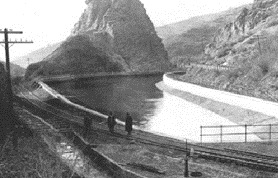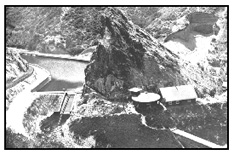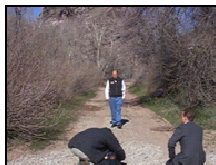Parleys Canyon Reservoir - A Look Back to Yesterday
“The [reservoir] water that allowed the little city to grow.” Craig Wirth
LeRoy W. Hooton, Jr.
May 11, 1999
|
The television story was about Suicide Rock, but from the Department of Public Utilities’ point of view the water was the bigger story. Built between 1879 - 1892, the Parleys Canyon Reservoir’s left abutment was anchored into the old rock, known then as Sentinel Rock (Suicide Rock). The dam and diversion point was Salt Lake City's first attempt to develop a local canyon water supply outside its corporate limits. The 1.6 million-gallon reservoir was the head works to the Parleys Lower Conduit that conveyed Parleys Canyon Creek water approximately 6 miles to the First South and 1300 East Reservoir. The City needed the water to grow, and the farmers needed stored water from Utah Lake to ensure that their crops matured in the late summer and fall months. It was an exchange of water that helped both sides and would be the pattern for future exchanges with other canyon creek water rights owners.
In 1888, Salt Lake City entered into an exchange agreement with the Parleys Water Users Association (farmers). The City provided the farmers water from Utah Lake through the Jordan & Salt Lake City Canal. In turn the City diverted their water into the Parleys Canyon Reservoir and Lower Conduit for municipal uses. The farmers had 8 diversions (ditches) irrigating nearly 2,500 acres of farmland.
The reservoir was used as an early water treatment process. The heavy silts and dirt were settled out in the slow moving water in the reservoir. Today, water is fully treated in modern water treatment plants before being delivered in the water distribution system to the consumer's tap. But in 1892, the only treatment the water received was settling the heavy solids. According to the 1913 Municipal Record, the reservoir would be drained every 3 months and cleaned. “Taking 6-1/2 hours, the men using long handled brushes, hoes and shovels," literally scrubbed the reservoir sides and bottom. The mud was hauled away in buckets. Later in 1917, chlorine was added as a disinfectant to kill harmful bacteria.
|
In 1907, there was a screen house and caretaker’s residence located west of Suicide Rock. For many years the site was a focal distribution point for Salt Lake City’s water supply. But in time, things changed. In 1919, with the construction of the Parleys Highline Conduit, the point of diversion was moved 5 miles up-canyon to Mt. Dell Reservoir. It appears that the diversion from Parleys Creek into the Parleys Canyon Reservoir was eliminated sometime after that. There may have been continued diversions from the Big Cottonwood Canyon into the Parleys Lower Conduit for a number of years afterwards. Records show that the site was abandoned in 1953. Mt. Dell became the new diversion works.
In 1920, the 48-inch Big Cottonwood Conduit siphon was constructed to convey water to the Parleys Highline Conduit along the high east bench. In 1932, the Samual Park Reservoir was built southwest of Suicide Rock on high ground on the south side of Parleys canyon (about 3100 South and I-215), followed in 1953 by the Metropolitan Water District of Salt Lake City’s Terminal Reservoirs just south of Park Reservoir, thus shifting the water distribution point to these large finished water reservoirs.
|
In Mr. Wirth’s story line, he described the reservoir, as it appeared on the screen, “[the reservoir] water that allowed the little city to grow.” He was so right.
Questions regarding this article may be directed by e-mail to: leroy.hooton@ci.slc.ut.us


